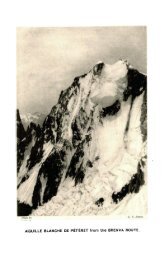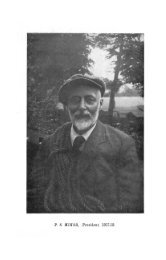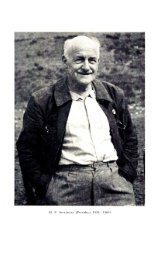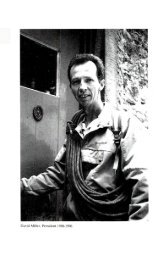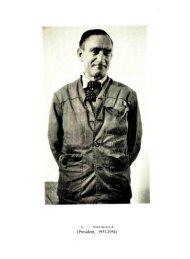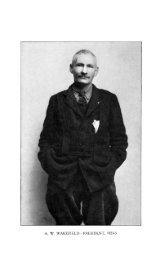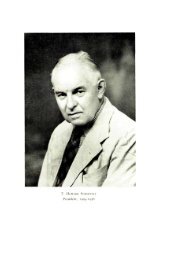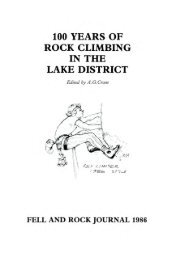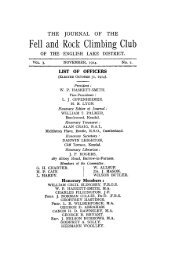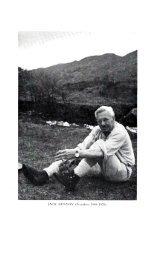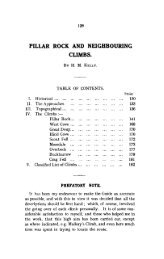Number in series 59; Year of publication 1966 - Fell and Rock ...
Number in series 59; Year of publication 1966 - Fell and Rock ...
Number in series 59; Year of publication 1966 - Fell and Rock ...
Create successful ePaper yourself
Turn your PDF publications into a flip-book with our unique Google optimized e-Paper software.
Roger Tufft 221<br />
ridges which <strong>in</strong>creased <strong>in</strong> height <strong>and</strong> frequency as the<br />
downward-flow<strong>in</strong>g ice was held back by the reta<strong>in</strong><strong>in</strong>g wall <strong>of</strong><br />
l<strong>and</strong>. These ridges were <strong>of</strong>ten as high as 30 feet <strong>and</strong> wrought<br />
fearful damage to the sledge each time it crashed downwards.<br />
At this po<strong>in</strong>t on the west coast there are no obvious l<strong>and</strong>marks<br />
<strong>and</strong> our sextant was only accurate to with<strong>in</strong> two miles.<br />
We could pick up the radio signals from the United States air<br />
base at Sondre Strom fiord but these were at the extreme<br />
range <strong>of</strong> our receiver <strong>and</strong> aga<strong>in</strong> only accurate to with<strong>in</strong> a few<br />
miles. We had hoped to strike l<strong>and</strong> at the po<strong>in</strong>t marked on the<br />
French maps as Po<strong>in</strong>t 660 metres <strong>and</strong> for some days we had<br />
been mak<strong>in</strong>g for an object visible above the ice-cap which we<br />
assumed to be Po<strong>in</strong>t 660. However, when some five miles<br />
from l<strong>and</strong>, we decided that it was impossible for the rocks,<br />
towards which we were head<strong>in</strong>g, to be Po<strong>in</strong>t 660. Our aerial<br />
photographs showed Po<strong>in</strong>t 660 to be a sharp arrow head <strong>of</strong><br />
rock po<strong>in</strong>t<strong>in</strong>g east-west <strong>in</strong>to the ice-cap. We were look<strong>in</strong>g at<br />
a long bluff runn<strong>in</strong>g north-south. We had, <strong>in</strong> fact, arrived<br />
some five miles too far north, <strong>and</strong> these extra five miles were<br />
to cost us another two days on the ice.<br />
The next day whilst two <strong>of</strong> us back-packed loads across the<br />
rema<strong>in</strong><strong>in</strong>g miles to Po<strong>in</strong>t 660, the other two re-lashed the<br />
badly battered sledge <strong>and</strong> replaced a damaged front bridge.<br />
In the late afternoon, whilst mov<strong>in</strong>g once more, we noticed<br />
some odd debris which at first we mistook for mora<strong>in</strong>e.<br />
Suddenly, we were <strong>in</strong> the middle <strong>of</strong> a fantastic depot <strong>of</strong> some<br />
5,000 beer cans scattered for about 400 yards on the ice.<br />
Many were burst but thous<strong>and</strong>s were <strong>in</strong>tact <strong>and</strong> the iced beer<br />
tasted wonderful <strong>in</strong> the heat <strong>and</strong> glare <strong>of</strong> the sun. (We<br />
speculated <strong>and</strong> argued as to their orig<strong>in</strong>, <strong>and</strong> only later discovered<br />
that they had been part <strong>of</strong> a condemned stock from<br />
the American air base at Sondre Strom. The Americans had<br />
disposed <strong>of</strong> them by dump<strong>in</strong>g them from an aircraft whilst<br />
fly<strong>in</strong>g over the ice-cap.)<br />
Our last day on the ice-cap was the hottest. In a temperature<br />
<strong>of</strong> 45°C <strong>and</strong> under a blaz<strong>in</strong>g hot sun, we manoeuvred<br />
the sledge through the last few miles <strong>of</strong> contorted pressure<br />
ridges. Suddenly Po<strong>in</strong>t 660 was upon us—a mere 400 yards<br />
away—rather an anticlimax after the days <strong>of</strong> toil <strong>and</strong> speculation,<br />
for the ridge simply phased <strong>in</strong>to the ice-cap <strong>and</strong> did not<br />
st<strong>and</strong> out as the bold f<strong>in</strong>ger <strong>of</strong> rock we had expected. Yet it<br />
was l<strong>and</strong>—the first s<strong>in</strong>ce the east coast—<strong>and</strong> it was like<br />
stepp<strong>in</strong>g ashore as we pitched camp that night on the s<strong>of</strong>t



